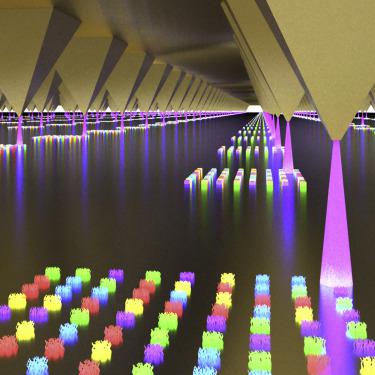Chem ( IF 19.1 ) Pub Date : 2018-03-08 , DOI: 10.1016/j.chempr.2018.01.020 Carlos Carbonell , Daniel J. Valles , Alexa M. Wong , Mei Wai Tsui , Moussa Niang , Adam B. Braunschweig

|
Multiplexed microarrays—where different biological probes are spatially encoded onto a surface into spots with micrometer-scale diameters—have facilitated the rapid advancement of “omics” research. Further miniaturization of feature diameters could increase the number of probes in a microarray, reduce the sample required for analysis, and decrease costs. Tip-based lithography (TBL) has gained popularity for patterning delicate, biologically active materials, but no versatile TBL-based multiplexing strategy has been devised. Here, we combine microfluidics, beam pen lithography, and photochemical surface reactions to create multiplexed arrays. For proof of concept, the thiol-ene reaction was optimized, and the reaction kinetics were analyzed. Subsequently, we created several patterns containing multiple fluorescent alkenes, where each pattern was designed to demonstrate a different capability of this instrument. This patterning strategy is a powerful approach to studying and optimizing organic reactions on surfaces and creating massively multiplexed arrays and, as such, could provide an entirely new approach for miniaturizing biochips or understanding interfacial reactivity.
中文翻译:

连续毛细流动下基于团簇的基于尖端的光化学光刻技术
复用微阵列(将不同的生物探针在空间上编码成具有微米级直径的斑点)促进了“组学”研究的快速发展。特征直径的进一步小型化可以增加微阵列中探针的数量,减少分析所需的样品,并降低成本。基于尖端的光刻(TBL)在图案化精致的生物活性材料方面已广受欢迎,但尚未设计出通用的基于TBL的多路复用策略。在这里,我们结合了微流控技术,束笔光刻技术和光化学表面反应来创建多重阵列。为了进行概念验证,对硫醇-烯反应进行了优化,并对反应动力学进行了分析。随后,我们创建了包含多个荧光烯烃的几种模式,每种模式都旨在证明该仪器的不同功能。这种图案化策略是研究和优化表面有机反应并创建大量多路复用阵列的有力方法,因此可以为使生物芯片小型化或了解界面反应性提供全新的方法。











































 京公网安备 11010802027423号
京公网安备 11010802027423号